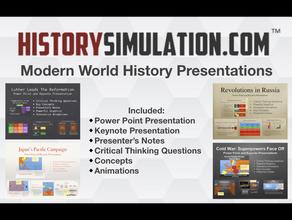MODERN WORLD HISTORY PRESENTATIONS
CAPTURE STUDENT'S INTEREST WITH ENGAGING HISTORY POWERPOINTS
If you're looking for more than just a picture and bullet points-you are in the right place! Mr. Harms not only creates a lot of his own graphics but also animates them as well in these History Presentations.
World History Patterns of Interaction Modern World History Presentations
Unit 3 An Age of Exchange and Encounter (500-1500 AD)
Module 8: The Muslim World (600-1250 AD)
Module 9: Empires In East Asia (600-1400 AD)
Module 10: European Middle Ages (500-1200 AD)
Module 11: Church and Society In Western Europe (800-1500 AD)
Module 12: Societies and Empires of Africa (1500 BC-1500 AD)
Unit 4 Connecting Hemispheres (500-1800 AD)
Module 13 : People and Empires In The Americas (30,000 BC-1500 AD)
Module 14: The Renaissance (1300-1500 AD)
Module 15: Reformation & Upheaval (1400-1600 AD)
Module 16: Expansion, Exploration and Encounters (1400-1800 AD)
Unit 5 Absolutism To Revolution (1500-1900 AD)
Module 17: Absolute Monarchs In Europe (1500-1800 AD)
Module 18 Enlightenment and Revolution (1500-1800 AD)
Module 19: The French Revolution and Napoleon (1789-1815 AD)
Module 20: Revolutions Sweep The West (1800-1900 AD)
Unit 6 Industrialism and The Race For Empire (1700-1914 AD)
Module 21: The Industrial Revolution (1700-1900 AD)
Module 22: An Age of Democracy and Progress (1815-1915 AD)
Module 24: Transformations Around The Globe (1800-1925 AD)
Module 23: The Age of Imperialism (1850-1915 AD)
Unit 7 The World At War (1900-1945 AD)
Module 24: Transformations Around the Globe (1800-1925 AD)
Module 25: World War I (1914-1918 AD)
Module 26: Revolution and Nationalism (1900-1940 AD)
Module 27: Years of Crisis (1919-1939 AD)
Module 28: World War II (1939-1945 AD)
Unit 8 Perspectives On The Present (1945-Present)
Module 29: Cold War Conflicts (1945-Present)
Module 30: The Colonies Become New Nations (1945-2005 AD)
Module 31: Struggles For Democracy (1945-Present)
Module 32: Global Interdependence (1960-2015 AD)
These materials were prepared by Harms LLC and have neither been developed, reviewed, nor endorsed by Houghton Mifflin Harcourt Publishing Company, publisher of the original WORLD HISTORY: Patterns of Interaction work on which this material is based.

